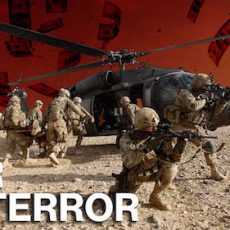*Original article is at: http://essays.ssrc.org/10yearsafter911/the-psychology-of-terrorism/
1. Terrorism as a Category of Violence
In a global war on terrorism, it is important to ask what we mean by terrorism.
The usual definition of terrorism is something like “the use or threat of violence, by small groups against non-combatants of large groups, for avowed political goals.” The key to this definition is the combination of small groups killing non-combatants. Terrorism is the warfare of the weak, the recourse of those desperate for a cause that cannot win by conventional means. But it is worth noting that state terrorism against a state’s own citizens–as practiced by Mao, Stalin, Hitler, Pol-Pot, and many smaller-league tyrants–has killed millions of non-combatants, whereas the anti-state terrorism we usually focus on has killed thousands.
The distinction between combatants and non-combatants–between people in uniform and people not in uniform–has been eroding since the French Revolution. The Revolution brought a new kind of army, a “nation in arms” that vanquished the best professional armies of Europe. Since then, the Western way of war has triumphed, and only a nation in arms has been able to beat a nation in arms. The implication of this shift is that the nation behind an army is a legitimate target of war.
The U.S. has accepted this implication on numerous occasions. In WWII, the U.S. dropped fire bombs on Dresden, Hamburg, and Tokyo, and nuclear bombs on Hiroshima and Nagasaki. These cities had relatively few in uniform; most of the dead were old people, women, and children. When the U.S. bombed Milosovic’s Serbia, targets included transportation, communication, and power centers and the casualties included many not in uniform. When the U.S. and its allies embargoed Saddam Hussein’s Iraq, the shortages of food and medicine killed more children than men in uniform.
As terrorism from above is not always called terrorism, so terrorism from below is not always called terrorism. At least for some Americans, the Contras were not terrorists and the Irish Republican Army are not terrorists. It seems unlikely that the U.S. will never again want to distinguish terrorists from freedom-fighters, in order to support the latter despite their attacks on civilians. Perhaps we ought to be honest in seeking to punish and interdict whatever groups are behind the attacks of 9/11, and go easy on talk about a global war on terrorism.
2. Terrorism as Individual Pathology
A common suggestion is that there must be something wrong with terrorists. Terrorists must be crazy, or suicidal, or psychopaths without moral feelings or feelings for others. Thirty years ago this suggestion was taken very seriously, but thirty years of research has found psychopathology and personality disorder no more likely among terrorists than among non-terrorists from the same background. Interviews with current and former terrorists find few with any disorder found in the American Psychiatric Association’s Diagnostic and Statistical Manual. Comparisons of terrorists with non-terrorists brought up in the same neighborhoods find psychopathogy rates similar and low in both groups.
Another way to think about this issue is to imagine yourself a terrorist, living an underground existence cut off from all but the few who share your goals. Your life depends on the others in your group. Would you want someone in your group suffering from some kind of psychopathology? Someone who cannot be depended on, someone out of touch with reality? Of course there are occasional lone bombers or lone gunmen who kill for political causes, and such individuals may indeed suffer from some form of psychopathology. But terrorists in groups, especially groups that can organize attacks that are successful, are likely to be within the normal range of personality.
Indeed terrorism would be a trivial problem if only those with some kind of psychopathology could be terrorists. Rather we have to face the fact that normal people can be terrorists, that we are ourselves capable of terrorist acts under some circumstances. This fact is already implied in recognizing that military and police forces are eminently capable of killing non-combatants in terrorism from above. Few suggest that the broad range of military and police involved in such killing must all be abnormal. Since 9/11, there have already been suggestions that the U.S. security forces may need to use torture to get information from suspected terrorists. This is the edge of a slippery slope that can lead to killing non-combatants.
3. Terrorism as Normal Psychology
No one wakes up one morning and decides that today is the day to become a terrorist. The trajectory by which normal people become capable of doing terrible things is usually gradual, perhaps imperceptible to the individual. This is among other things a moral trajectory, such as Horowitz has described in “The Deadly Ethnic Riot.” In too-simple terms, terrorists kill for the same reasons that groups have killed other groups for centuries. They kill for cause and comrades, that is, with a combination of ideology and intense small-group dynamics.
The cause that is worth killing for and even dying for is personal, a view of the world that makes sense of life and death and links the individual to some form of immortality. Every normal person believes in something more important than life. We have to, because, unlike other animals, we know that we are going to die. We need something that makes sense of our life and our death, something that makes our death different from the death of a squirrel lying by the side of the road that we drive to work. The closer and more immediate death is, the more we need the group values that give meaning to life and death. These values include the values of family, religion, ethnicity, and nationality-the values of our culture. Dozens of experiments have shown that thinking about our own death leads us to embrace more strongly the values of our culture (“terror management theory”).
There is no special association between religion and violence. Many of the terrorist groups since WWII have been radical-socialist groups with no religious roots: the Red Brigade in Italy, the Baader-Meinhof Gang and the Red Army Faction in Germany, the Shining Path in Peru. Animal rights and saving the environment can be causes that justify terrorism. For much of the twentieth century, atheistic communism was such a cause.
The group values represented in the cause are focused to a personal intensity in the small group of like-minded people who perpetrate terrorist violence. Most individuals belong to many groups–family, co-workers, neighborhood, religion, country–and each of these groups has some influence on the beliefs and behavior of the individual. These groups tend to have different values and the competition of values reduces the power of any one group over its members. But members of an underground terrorist group have put this group first in their lives, dropping or reducing every other connection. The power of this one group is now enormous, and extends to every kind of personal and moral judgment. This is the power that can make violence against the enemy not just acceptable but necessary.
Every army aims to do what the terrorist group does: to link a larger group cause with the small group dynamics that can deliver individuals to sacrifice. Every army cuts trainees off from their previous lives so that the combat unit can become their family, their fellow-soldiers become their brothers, and their fear of letting down their comrades greater than their fear of dying. “Perfect love casts out fear.”
The power of an isolating group over its members is not limited to justifying violence. Many non-violent groups also gain power by separating individuals from groups that might offer competing values. Groups using this tactic include religious cults, drug treatment centers, and residential schools and colleges.
In brief, the psychology behind terrorist violence is normal psychology, abnormal only in the intensity of the group dynamics that link cause with comrades.
4. Terrorist Strategy
Psychologists recognize two kinds of aggression, emotional and instrumental. Emotional aggression is associated with anger and does not calculate long-term consequences. The reward of emotional aggression is hurting someone who has hurt you. Instrumental aggression is more calculating — the use of aggression as a means to other ends. Terrorist aggression may involve emotional aggression, especially for those who do the killing, but those who plan terrorist acts are usually thinking about what they want to accomplish. They aim to inflict long-term costs on their enemy and to gain long-term advantage for themselves.
Terrorism inflicts immediate damage in destroying lives and material, but terrorists hope that the long-term costs will be much greater. They want to create fear and uncertainty far beyond the victims and those close to them. They want the enemy to spend time and money on security. In effect the terrorists aim to lay an enormous tax on every aspect of the enemy’s society, a tax that transfers resources from productive purposes to anti-productive security measures. The costs of increased security are likely to be particularly high for a country like the U.S., where an open society is the foundation of economic success and a high-tech military.
Terrorists particularly hope to elicit a violent response that will assist them in mobilizing their own people. A terrorist group is the apex of a pyramid of supporters and sympathizers. The base of the pyramid is composed of all those who sympathize with the terrorist cause even though they may disagree with the violent means that the terrorist use. In Northern Ireland, for instance, the base of the pyramid is all who agree with “Brits Out”. In the Islamic world, the base of the pyramid is all those who agree that the U.S. has been hurting and humiliating Muslims for fifty years. The pyramid is essential to the terrorists for cover and for recruits. The terrorists hope that a clumsy and over-generalized strike against them will hit some of their own side who are not yet radicalized and mobilized, will enlarge their base of sympathy, will turn the sympathetic but unmobilized to action and sacrifice, and will strengthen their own status at the apex of this pyramid.
They have reason to be hopeful. In 1986, for instance, the U.S. attempted to reply to Libyan-supported terrorism by bombing Libya’s leader, Khaddafi. The bombs missed Khaddafi’s residence but hit a nearby apartment building and killed numbers of women and children. This mistake was downplayed in the U.S. but a public relations success for anti-U.S. groups across North Africa. In 1998, the U.S. attempted to reply to attacks on U.S. embassies by sending cruise missiles against terrorist camps in Afghanistan and against a supposed bomb factory in Khartoum. It appears now that the “bomb factory” was in fact producing only medical supplies.
A violent response to terrorism that is not well aimed is a success for the terrorists. The Taliban did their best to play up the bombs that killed civilians in Afghanistan.
Terrorists also hope for a reaction of stereotyping and prejudice in which the terrorists are seen as typical members of the cause they say they are fighting for. Usually the terrorists are only a tiny splinter of the group they aim to lead. Their most dangerous opposition is often from their own side, from moderates who see alternatives other than violence. If the response to terrorist attack is to lump together all who sympathize with the cause the terrorists claim to serve, to see a whole ethnic or religious group as dangerous and violent, then the moderates are undermined and the terrorists win.
A reaction of stereotyping and prejudice toward Arabs and Muslims living in the U.S. will turn them from sources of help against terrorism to sources of further terrorism. Rudeness, suspicion and hostility directed toward Arabs and Muslims in the U.S. is good news for the terrorists. “Profiling” or other infringement of civil rights of Arabs and Muslims by U.S. agencies of state security can help encourage a sense of victimization. Some of the thousand of so Arabs and Muslims jailed since 9/11 on suspicion of terrorist activities are likely to feel aggrieved, when they are finally released.
In U.S foreign policy, a reaction of threat and hostility toward Arabs and Muslims might be even more dangerous. “Join our war against terrorism or else” runs the risk of undermining Western-leaning governments of states where fundamentalist Muslim forces are contesting government cooperation with the West: Saudi Arabia, Egypt, Jordan, Pakistan. If the reaction to terrorism is seen as a crusade against Muslims, the terrorists will be positioned to lead a jihad that begins at home. Easy talk about moving U.S. forces from Afghanistan to Iraq can only reinforce Muslim fears that there is a crusade embarked.
5. From Criminal Justice to War
Since the first bombing attack on the World Trade Center, the U.S. response to terrorism has shifted from criminal justice — finding, trying and punishing perpetrators –to waging war. This shift has psychological consequences.
Framing terrorism and response to terrorism implies a movement from individual blame to group blame. This is just what the terrorists want. They want to be seen as representing all who feel that the U.S. has since WWII dominated, humiliated, and helped to kill Muslims. They want responsibility for their actions projected to all who sympathize with their cause. It should be our business not to accept the terrorists as leaders of a billion Muslims. Rather we should inquire into the policies of the U.S. that could create so much anti-American feeling around the world.
The shift to a rhetoric of war also signals the possibility of more extreme and expensive measures against terrorism. A more pro-active policy against terrorism is being called for. There are some unfortunate models of what this kind of policy might look like. Our pro-active policy against Viet Cong terrorism included the Phoenix Program, which sent snipers and Special Forces teams to assassinate people suspected of Viet Cong activity. This program was unfortunate not only in dispensing with the process of law but in being ultimately unsuccessful.
Our most recent pro-active war is the war on drugs. We pay or threaten foreign countries to drop poison on their own farms where farmers are growing crops Americans want to buy. We put money and training into the military and security forces of these countries. We support undercover agents to penetrate drug rings and develop intelligence against them. See the film “Traffic” for a recent review of what this war means on the ground — and for a progress report on its success.
The domestic costs of increased security are the costs of a more centralized state that can become the enemy of its own people. In the U.S., the government has already assumed new powers without consulting Congress. Polls taken in years preceding the terrorist attack on 11 September indicate that about half of adult Americans saw the federal government as a threat to the rights and freedoms of ordinary Americans. No doubt fewer would say so in the aftermath of the recent attacks, a shift consistent with the adage that “war is the health of the state.” But if more security could ensure the safety of the nation, the Soviet Union would still be with us.
6. Conclusion
The response to terrorism can be more dangerous than the terrorists. Relaxing into the warmth of anger and war against terrorism will not honor those who died in the attacks of 9/11. We have to think.
*Read the original article at: http://essays.ssrc.org/10yearsafter911/the-psychology-of-terrorism/






